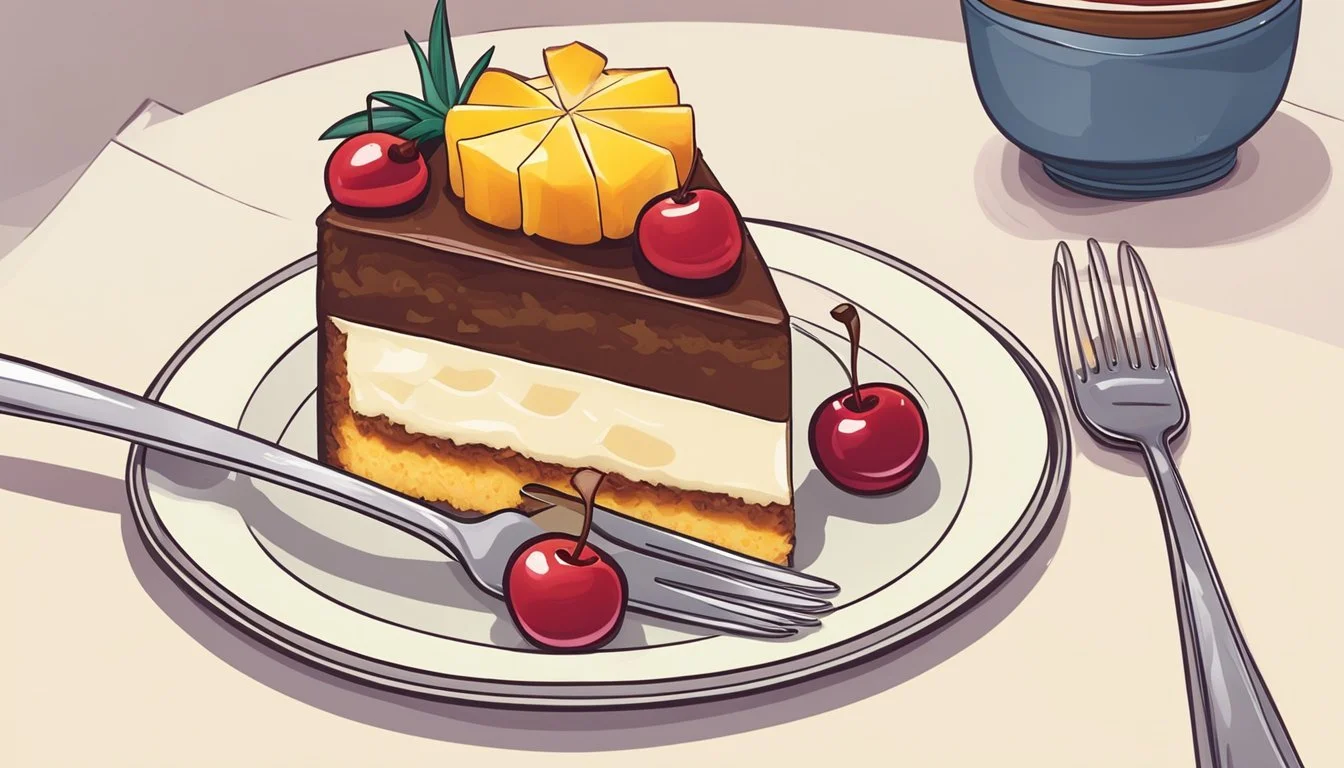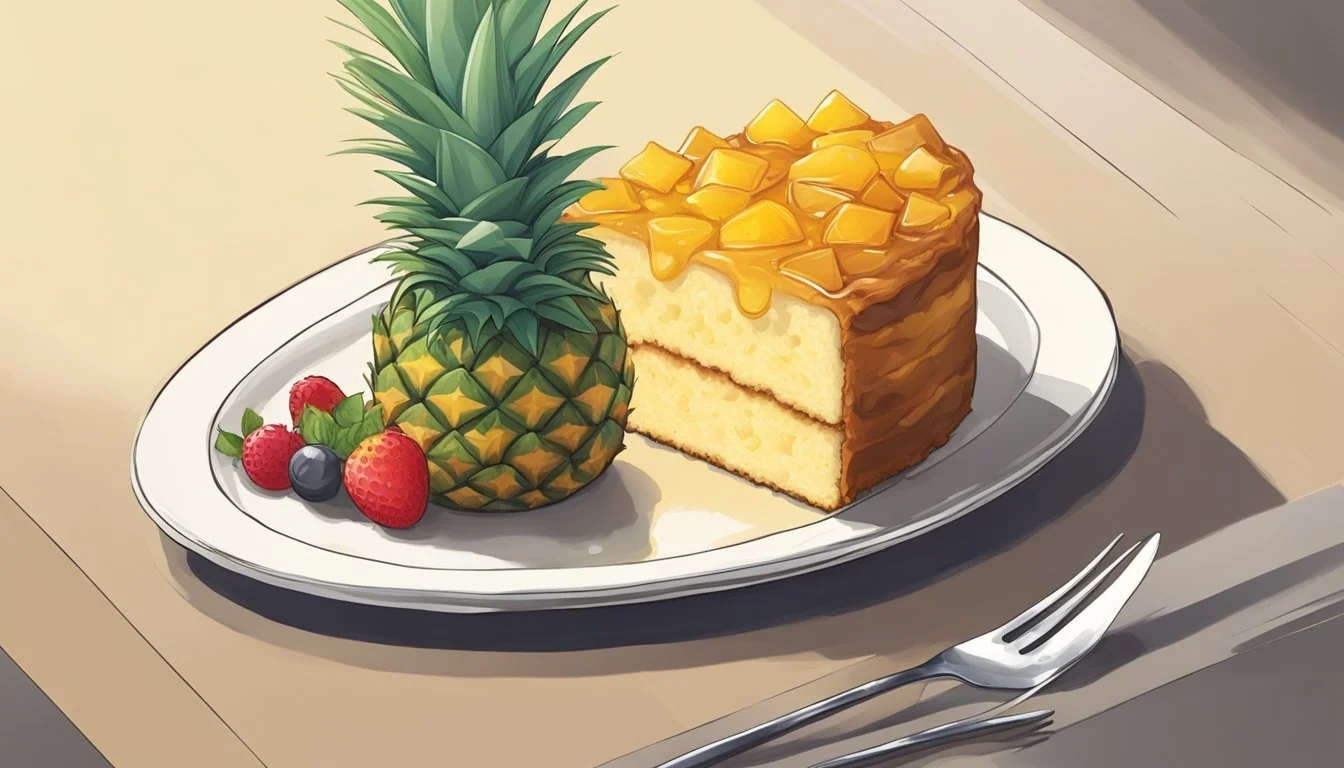How do you eat an upside-down pineapple cake?
Serving Tips for Maximum Enjoyment
Eating an upside-down pineapple cake is a delightful experience that harks back to a classic American dessert tradition. The cake itself is characterized by its caramelized topping of pineapple rings and cherries (how long do cherries last?), which forms a deliciously sticky and sweet layer above a soft, fluffy sponge. When served, the cake is inverted so the fruit topping is displayed on the plate, showcasing the golden pineapple slices and glistening red cherries as the stars of the dish.
The process of eating an upside-down pineapple cake is simple yet indulgent. Upon inversion, the caramelized fruit juices seep further into the sponge, enhancing the moistness and flavor of the cake. Every bite combines the buttery richness of the sponge with the tangy sweetness of the pineapple, often complemented by the occasional tartness of the cherries.
To fully appreciate this dessert, it should be served warm, which helps to highlight the contrast between the tender cake and the slightly crispier, caramelized topping. It pairs exceptionally well with a scoop of vanilla ice cream or a dollop of whipped cream, although it stands up on its own as a well-loved classic. Whether enjoyed as a finale to a meal or as a standalone treat, upside-down pineapple cake sits comfortably within the canon of comfort food favorites.
Essentials of Upside-Down Pineapple Cake
The essence of the upside-down pineapple cake hinges on its rich history, distinctive ingredients, and precise baking techniques. This section unveils the origins, key components, and equipment necessary to create this iconic dessert.
Exploring Pineapple Upside-Down Cake Origins
The upside-down pineapple cake gained popularity in the early 20th century, notably in the United States. Its creation is often associated with the introduction of canned pineapple by companies like Dole, which made the tropical fruit more accessible to home bakers. This dessert showcases caramelized pineapple pieces at the bottom of the pan, which becomes the top once inverted after baking, imparting a unique presentation and flavor.
Key Ingredients for the Perfect Cake
Creating the perfect upside-down pineapple cake hinges on a combination of staple ingredients and a balance of flavors. Key ingredients include:
Pineapple: Fresh or canned pineapple slices form the caramelized top layer.
Butter: Melted butter is combined with brown sugar to create the rich caramel topping.
Brown Sugar: For a deep, molasses flavor that infuses with the pineapple.
Batter Essentials: A typical batter consists of flour, sugar, and eggs.
Leavening Agents: Baking powder or baking soda ensures a fluffy, well-risen cake.
Wet Ingredients: Milk, vanilla extract, and sometimes sour cream add moisture and richness.
Cherries: Often placed in the center of pineapple rings for extra sweetness and visual appeal.
Suitable Baking Equipment and Oven Settings
To navigate the baking process effectively, the proper equipment and accurate oven temperatures are critical:
Cake Pan: A heavy, ovenproof skillet or round cake pan is ideal.
Oven Temperature: Preheating to 350ºF (175ºC) is commonly recommended.
Convection Adjustment: If using a convection oven, reduce temperature by 25ºF (15ºC).
Preparation: The pan is often pre-buttered before arranging the pineapple and adding the batter.
To enjoy an upside-down pineapple cake at its best, one should allow it to cool slightly before inverting it onto a serving plate. This ensures the pineapple and caramel layer remains intact, providing the signature look and taste that makes this dessert a timeless favorite.
Preparation Techniques
In making an upside-down pineapple cake, precision in preparing ingredients creates the foundation for this classic dessert. One begins by preparing the pineapple, crafting the cake batter, and finally, assembling the layers in the pan, all requiring specific steps to ensure a perfect outcome.
Preparing the Pineapple
To lay the groundwork for this dessert, canned pineapple slices offer convenience and consistent sweetness. A baker must drain the slices well and pat them dry to prevent excess moisture from altering the cake's texture. Brown sugar and unsalted butter are typically melted together in the cake pan before arranging the pineapple slices on top to create the caramelized topping once inverted.
Mixing the Cake Batter
For the batter, a mixture of all-purpose flour, baking powder, and salt is sifted to ensure a fine, lump-free consistency. In a separate bowl, unsalted butter and sugar are creamed until light and airy, which might take about 3 to 4 minutes. One then adds eggs one at a time, fully incorporating each before adding the next. Ingredients like vanilla extract and sour cream are mixed in to enrich the flavor and texture, ensuring the cake remains moist. Alternating between the dry ingredients and a blend of milk and pineapple juice, one keeps mixing until the batter is smooth and well combined.
Assembling the Layers in the Pan
To assemble, the prepared pan with caramelized sugar and pineapple slices is the base onto which the batter is gently poured. Ensuring the batter is evenly distributed is crucial; it provides a uniform layer that will bake consistently. Once assembled, it is essential to bake immediately to prevent the batter from sitting too long and potentially deflating, ensuring a robust and tender crumb upon completion.
Baking and Inverting the Cake
The baking and inverting of an upside-down pineapple cake are critical steps in achieving a moist, soft, and fluffy dessert. Proper timing and techniques ensure that the cake maintains its texture and form when served.
Baking Process and Times
Preheat the oven to 350°F (180°C) before starting the cake batter. It's essential for the cake batter to go into an oven at the right temperature to bake evenly. A typical upside-down pineapple cake requires baking for 30 to 45 minutes. To verify if the cake is done, one should insert a toothpick into the center; if it comes out clean, the cake is ready. The baking process is aimed at creating a soft and fluffy texture, with the necessary moisture retained within the cake.
Cooling and Inverting Techniques
Once the cake is baked, it should initially cool in the pan for 10 minutes. This allows the cake to set and decreases the chance of it falling apart during inversion. For inverting the cake, place a flat plate over the top of the cake pan and carefully flip both plate and pan in a smooth, confident motion. Then, gently remove the pan. It is crucial to use a plate that is slightly larger than the cake pan to catch any drippings. A cake that isn't adequately cooled may stick, while one that is too cool can become too firm to release properly. The total time from baking to inverting the cake directly influences the final presentation and texture of the cake.
Decoration and Serving Suggestions
The visual allure of an upside-down pineapple cake lies in its caramelized fruit topping which, when inverted, serves as a stunning, glossy centerpiece. Serving the cake with complementary accompaniments enhances the dining experience both aesthetically and flavor-wise.
Caramelized Fruit Toppings
The caramelized layer that crowns an upside-down pineapple cake isn't just for appeal; it also imparts a deep, rich flavor. To create this layer:
Arrange the pineapple slices at the bottom of the pan.
Dot with maraschino cherries for a pop of color and sweetness.
Spread a mixture of melted butter and brown sugar over the arranged fruit before pouring in the batter.
Bake until the sugar caramelizes to a golden hue, creating a deliciously sticky glaze.
This process not only embellishes the cake but also locks in moisture, creating a delicate balance between the tangy fruit and the sweet topping.
Serving with the Right Accompaniments
When presenting the cake, the choice of accompaniments can elevate the overall dessert experience:
Whipped Cream: A dollop of whipped cream offers a cool, light contrast to the warm, rich tones of the cake.
Ice Cream: Vanilla ice cream is a classic pairing for the cake, adding a creamy texture and a neutral flavor that doesn't overshadow the pineapple.
Frosting or Glaze: If additional sweetness is desired, a simple powdered sugar glaze or a thin layer of frosting can be drizzled atop the cake once flipped.
Garnish: A sprig of mint or a dusting of powdered sugar can add a final touch of elegance.
Whether enjoyed with a cup of tea or as a festive dessert, these decoration and serving suggestions are designed to ensure that the upside-down pineapple cake makes a confident and pleasing statement at any table.
Variations and Related Recipes
Exploring variations of the classic pineapple upside-down cake allows for creativity in presentation and tailoring to specific dietary preferences. From the elegance of a Bundt cake to modifications for gluten-free or vegan diets, these adaptations ensure that everyone can enjoy this delightful dessert.
Pineapple Upside-Down Bundt Cake
A majestic twist on the traditional is the Pineapple Upside-Down Bundt Cake. This version incorporates the familiar caramelized pineapple and cherries into a sculptural Bundt shape, providing a stunning centerpiece. The Bundt cake's grooves elegantly display the pineapple rings and cherries, infusing the vanilla cake with both visual appeal and rich flavor throughout.
Adapting for Different Dietary Needs
Modern dietary needs have necessitated the creation of gluten-free and vegan versions of the pineapple upside-down cake. Gluten-free adaptations may substitute wheat flour with a blend of rice and almond flours to maintain a similar texture. For a vegan rendition, ingredients such as dairy butter and eggs are replaced with plant-based alternatives like coconut oil and ground flaxseed or applesauce to bind the cake. These substitutes are carefully selected to mirror the moist and flavorful experience of the classic cake, ensuring that dietary restrictions do not compromise taste.
Post-Baking Tips
Once the pineapple upside-down cake has cooled and been enjoyed, proper storing, freezing, and serving methods ensure the cake remains as delightful as when it was first baked.
Storing and Refrigerating the Cake
To store pineapple upside-down cake in the refrigerator, one should place toothpicks over the cake and gently drape plastic wrap over them to avoid the wrap sticking to the toppings. The cake should be kept in an airtight container if possible. This method helps maintain the cake's soft and fluffy texture for a few days.
Freezing and Thawing Instructions
For longer storage, freezing the cake is an option. Wrap the cake slices or entire cake securely in plastic wrap followed by a layer of aluminum foil. When ready to enjoy, one should thaw the cake in the refrigerator overnight to preserve its moisture and texture.
Serving Sizes and Portioning
A standard pineapple upside-down cake caters to approximately 12 servings. To serve, one should slice the cake into equal portions, ensuring each piece comprises a portion of the pineapple and cherry topping for a complete and satisfying dessert experience.
Advanced Techniques and Troubleshooting
While baking an upside-down pineapple cake, achieving optimal fluffiness and moisture is crucial. This section addresses techniques to enhance cake texture and solutions for common baking challenges.
Perfecting Cake Moisture and Fluffiness
To ensure the cake is moist and fluffy, attention to the creaming process is key. One should use an electric mixer to beat the softened butter and sugar until the mixture is pale and voluminous. This could take approximately 2 minutes on a medium to high speed. Incorporating eggs one at a time and beating well between additions further adds air and structure.
Cake flour is preferred for its lower protein content, which contributes to a tender crumb. In a medium bowl, one must whisk it with the other dry ingredients before gently folding them into the wet mixture with a rubber spatula. Overmixing at this stage can deflate the batter, so a light hand is essential.
Troubleshooting Common Baking Issues
When encountering issues such as a dense cake or uneven baking, a few troubleshooting steps can be taken:
Dense Cake: If the cake is too dense, check that the baking powder is fresh and that the correct amount of liquid was used. Also, ensure not to overmix the batter after adding the dry ingredients.
Uneven Baking: An oven not properly preheated or with hot spots can lead to uneven baking. Use an oven thermometer to verify temperature accuracy and rotate the cake halfway through baking.
By employing these techniques and being mindful during the baking process, one can greatly improve the odds of baking a successful upside-down pineapple cake.






